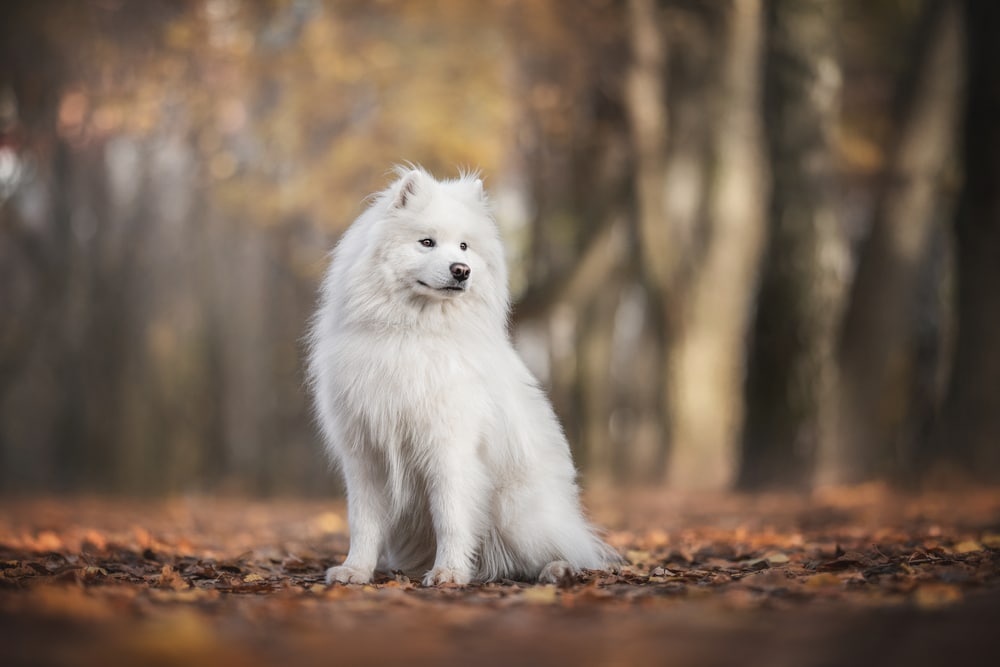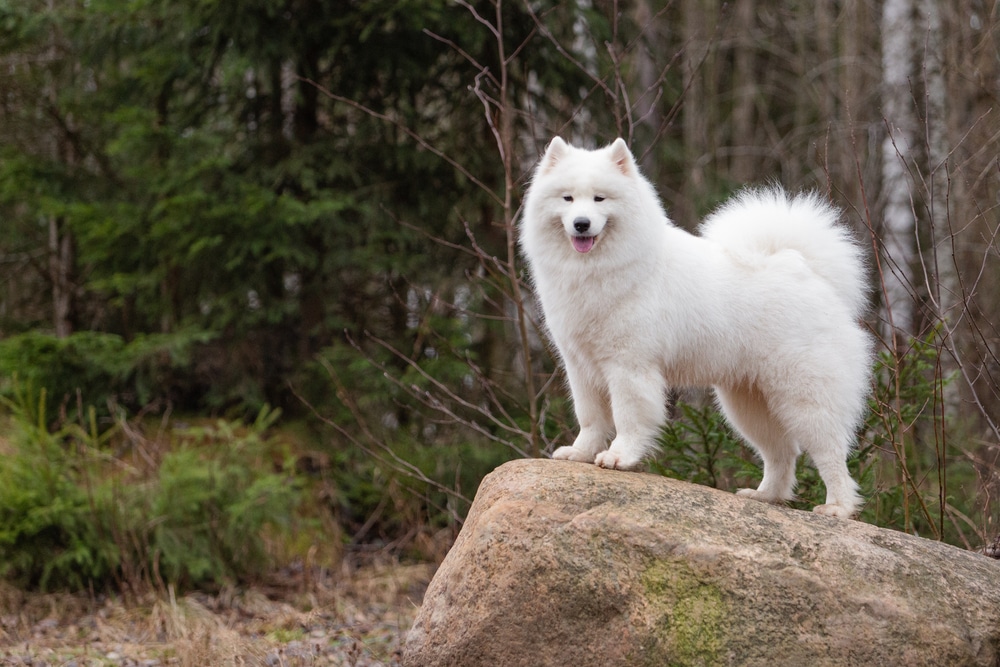When it comes to Samoyeds, Agnes Gru, the little girl from the animated movie Despicable Me 3 describes our sentiments best with her infamous quote, “It’s so fluffy I’m gonna DIE!!!”. So, why are Samoyeds so fluffy?
Samoyeds derive from the ancient breed Nenets Herding Laika. They were known to assist the Samoyedic people of Siberia in hunting, herding, and sled-pulling often in temperatures well below freezing. Their fur consists of two distinct layers that help protect them from harsh weather conditions. Along the way, we humans continued to favor dogs with the fullest coats. The appeal of these fluffy dogs meant they were more likely to be bred so that their genes would be passed down to the next generation.
Table of Contents
The Layers In A Samoyed’s Fluffy Coat

Sammies are a double-coated breed, similar to Shepherds, Collies, Golden and Labrador Retrievers, Pomeranians, Chows, Siberian Huskies, Great Pyrenees, Bernese Mountain Dogs, and Newfoundlands to name a few.
Their coat is made up of an outer layer of long, straight guard hairs that are waterproof and can shield them from rain and melting snow. The inner layer is soft and downy. This wool-like layer protects the dog from extreme temperatures by trapping a layer of air between the hair fibers that act as insulation against the heat and cold. It is largely the undercoat that contributes to how fluffy a Samoyed can get.
How Humans Contributed To Maintaining Samoyeds’ Fluffy Appearance
As Sammies differentiated from their ancestors to become their own breed, people began to identify traits they found appealing and wanted to foster. For example, they became well-known for their full white coats.
For Samoyeds, the AKC breed standard requires that their coats be “heavy and weather-resistant.” Being any color other than white, cream, and biscuit is grounds for disqualification in shows.
Our love for the characteristic Sammie appearance encouraged breeders to select the dogs with the best coats. Artificial selection allowed fluffy parents to pass their genes on to the next generation and so on. This allowed the preservation of the genetic traits for fluffiness even in dogs bred in warm climates.
Can Samoyeds Thrive In Warm Climates?
Yes! Siberian summer temperatures can soar over 20 °C (68 °F). A Samoyed’s double coat is designed to withstand these changes. The same inner layer that insulates them from the cold also keeps them cool on hot summer days. It does this by keeping the air closest to the skin at the ideal body temperature.
Despite this, living in an extremely hot environment isn’t normal for this breed. While they can survive, it is unlikely that they will thrive and be happy. If you live closer to the tropics or anywhere that experiences higher temperatures for most of the year, a Samoyed may be difficult to keep.
That said, Samoyeds living in warmer climates have a coarser coat with more top coat. Spending too much time in the sun can cause the hair to darken and turn brown, especially along their back. The colder the temperature, the lighter and downier your Sammie’s fur will be.
How To Make A Samoyed Comfortable In Hot Weather
As with any dog, prolonged exposure to high temperatures can be uncomfortable for Samoyeds. Make sure to provide them with access to shade and cool water when it’s hot outside and avoid exercise during the hottest part of the day.
Although it may seem like shaving off your Sammie in the summer is a good idea, this is actually not true. This takes away their natural ability to thermoregulate and the coat may never grow back in the normal way. Shaving your double-coated dog will NOT make them more comfortable. We never recommend this.
Providing your Samoyued with a fan or pool of water to play in instead will help them cool down. You can also introduce ice cubes or homemade doggy popsicles as a summer treat.
Yearly Shedding Cycles: What To Expect
While some hair loss is normal throughout the year, Samoyeds will “blow their coats” in the spring and fall in preparation for the changing season. This is a period of excessive shedding that allows your dog to rid itself of the lighter summer coat in exchange for thicker winter down and vice versa.
Also, intact female Samoyeds shed their fur in tandem with their heat cycles, usually twice a year. Males and spayed females will shed once a year during spring. Some owners report that spaying can cause females to shed consistently throughout the year rather than seasonally.
Grooming A Samoyed
Samoyeds also require extensive grooming. While it is not necessary to bathe them regularly, they need frequent brushing to eliminate dead hair and prevent tangles. Matted hair loses its thermoregulative ability and can leave your dog susceptible to temperature stress.
A deshedder brush or undercoat rake can be used to safely remove loose undercoat hairs that contribute to most of the fallout.
In Conclusion: Why Are Samoyeds Fluffy?
Samoyeds are fluffy because of their natural adaptations to harsh weather conditions and because we love their fluff so much we use “selective breeding” to keep it around. It is important to understand the requirements and maintenance that come with owning a dog with such a lush coat and preparing appropriately before choosing to get one.
